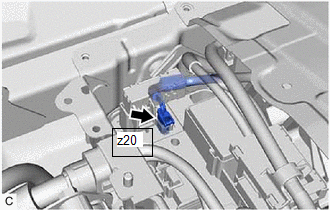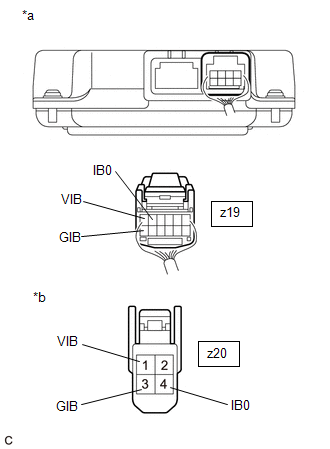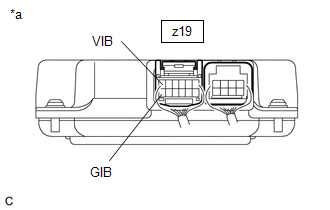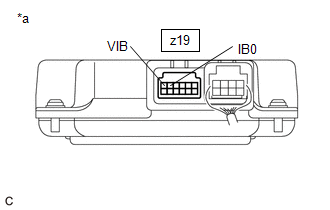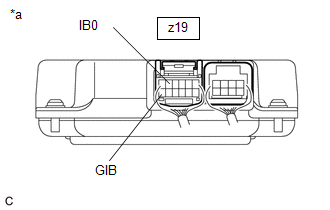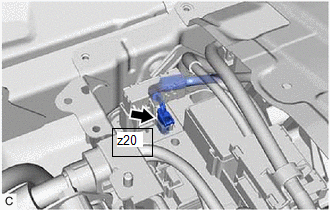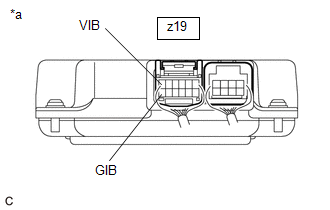| Last Modified: 01-30-2024 | 6.11:8.1.0 | Doc ID: RM100000001EKK7 |
| Model Year Start: 2019 | Model: RAV4 HV | Prod Date Range: [11/2018 - 06/2020] |
| Title: HYBRID / BATTERY CONTROL: HYBRID CONTROL SYSTEM (for 2WD with NICKEL METAL HYDRIDE BATTERY): P0ABF11,P0ABF15,P1CBB12,P1CBB14; Hybrid/EV Battery Current Sensor "A" Circuit Short to Ground; 2019 - 2020 MY RAV4 HV [11/2018 - 06/2020] | ||
|
DTC |
P0ABF11 |
Hybrid/EV Battery Current Sensor "A" Circuit Short to Ground |
|
DTC |
P0ABF15 |
Hybrid/EV Battery Current Sensor "A" Circuit Short to Auxiliary Battery or Open |
|
DTC |
P1CBB12 |
Hybrid/EV Battery Current Sensor Power Supply Circuit Short to Auxiliary Battery |
|
DTC |
P1CBB14 |
Hybrid/EV Battery Current Sensor Power Supply Circuit Short to Ground or Open |
DESCRIPTION
A battery current sensor is installed to the positive (+) terminal side of the HV battery and detects current flowing from the HV battery. The battery current sensor outputs voltage, which changes between 0 and 5 V according to the detected amperage, to the IB terminal of the battery voltage sensor. The battery voltage sensor sends signals to the hybrid vehicle control ECU assembly. The hybrid vehicle control ECU assembly determines the charging and discharging amount of the HV battery based on the received signals and calculates the SOC of the HV battery through the accumulated amperage.
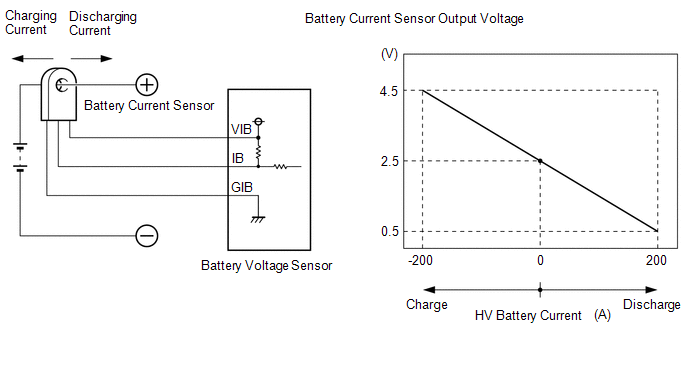
|
DTC No. |
Detection Item |
DTC Detection Condition |
Trouble Area |
MIL |
Warning Indicate |
|---|---|---|---|---|---|
|
P0ABF11 |
Hybrid/EV Battery Current Sensor "A" Circuit Short to Ground |
The battery current sensor output voltage is excessively low. (1 trip detection logic) |
|
Comes on |
Master Warning: Comes on |
|
P0ABF15 |
Hybrid/EV Battery Current Sensor "A" Circuit Short to Auxiliary Battery or Open |
The battery current sensor output voltage is excessively high. (1 trip detection logic) |
|
Comes on |
Master Warning: Comes on |
|
P1CBB12 |
Hybrid/EV Battery Current Sensor Power Supply Circuit Short to Auxiliary Battery |
Power source voltage of the battery current sensor is excessively high. (1 trip detection logic) |
|
Comes on |
Master Warning: Comes on |
|
P1CBB14 |
Hybrid/EV Battery Current Sensor Power Supply Circuit Short to Ground or Open |
Power source voltage of the battery current sensor is excessively low. (1 trip detection logic) |
|
Comes on |
Master Warning: Comes on |
Related Data List
|
DTC No. |
Data List |
|---|---|
|
P0ABF11 |
Hybrid Battery Current *1 |
|
P0ABF15 |
|
|
P1CBB12 |
|
|
P1CBB14 |
HINT:
*1: The value of "Hybrid Battery Current" will be approximately 0 A when the power switch is on (IG) (READY off).
CONFIRMATION DRIVING PATTERN
HINT:
After repair has been completed, clear the DTC and then check that the vehicle has returned to normal by performing the following All Readiness check procedure.
- Connect the Techstream to the DLC3.
- Turn the power switch on (IG) and turn the Techstream on.
- Clear the DTCs (even if no DTCs are stored, perform the clear DTC procedure).
- Turn the power switch off and wait for 2 minutes or more.
- Turn the power switch on (IG) and turn the Techstream on.
- With power switch on (IG) and wait for 10 seconds or more.
- Enter the following menus: Powertrain / Hybrid Control / Utility / All Readiness.
-
Check the DTC judgment result.
HINT:
- If the judgment result shows NORMAL, the system is normal.
- If the judgment result shows ABNORMAL, the system has a malfunction.
- If the judgment result shows INCOMPLETE, perform driving pattern again.
WIRING DIAGRAM
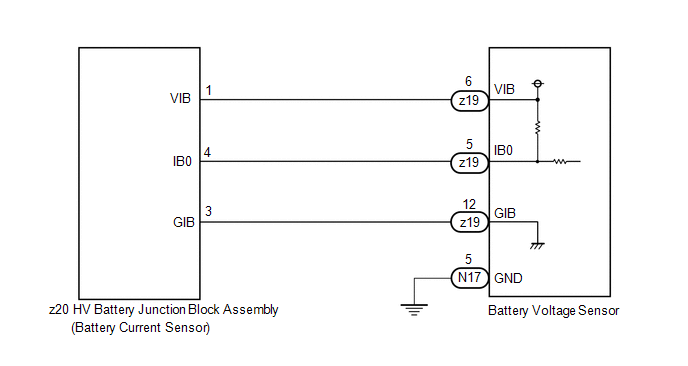
Refer to the wiring diagram for DTC P0AFC00.
CAUTION / NOTICE / HINT
CAUTION:
-
Before the following operations are conducted, take precautions to prevent electric shock by turning the power switch off, wearing insulated gloves, and removing the service plug grip from HV battery.
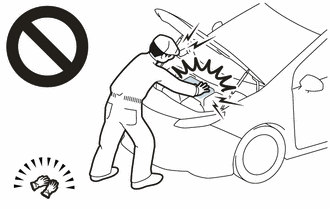
- Inspecting the high-voltage system
- Disconnecting the low voltage connector of the inverter with converter assembly
- Disconnecting the low voltage connector of the HV battery
-
To prevent electric shock, make sure to remove the service plug grip to cut off the high voltage circuit before servicing the vehicle.
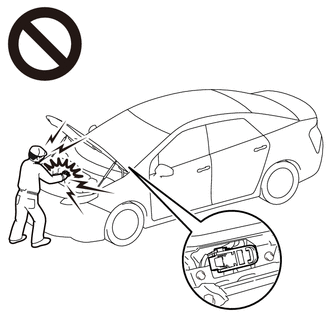
-
After removing the service plug grip from the HV battery, put it in your pocket to prevent other technicians from accidentally reconnecting it while you are working on the high-voltage system.
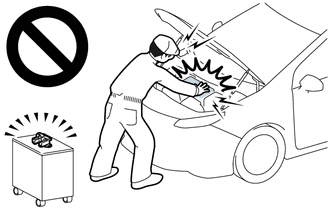
-
After removing the service plug grip, wait for at least 10 minutes before touching any of the high-voltage connectors or terminals. After waiting for 10 minutes, check the voltage at the terminals in the inspection point in the inverter with converter assembly. The voltage should be 0 V before beginning work.
HINT:
Waiting for at least 10 minutes is required to discharge the high-voltage capacitor inside the inverter with converter assembly.
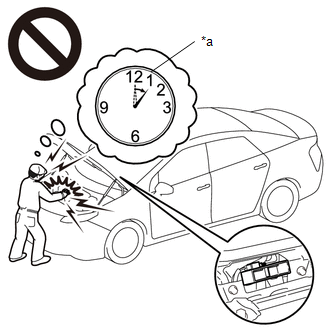
*a
Without waiting for 10 minutes
NOTICE:
After turning the power switch off, waiting time may be required before disconnecting the cable from the negative (-) auxiliary battery terminal. Therefore, make sure to read the disconnecting the cable from the negative (-) auxiliary battery terminal notices before proceeding with work.
PROCEDURE
|
1. |
CHECK DTC OUTPUT (HYBRID CONTROL) |
(a) Connect the Techstream to the DLC3.
(b) Turn the power switch on (IG).
(c) Enter the following menus: Powertrain / Hybrid Control / Trouble Codes.
(d) Check for DTCs.
Powertrain > Hybrid Control > Trouble Codes
|
Result |
Proceed to |
|---|---|
|
"P0AFC00, P0AFC96 or P308A12" is not output. |
A |
|
"P0AFC00, P0AFC96 or P308A12" is also output. |
B |
(e) Turn the power switch off.
| B |

|
|
|
2. |
CHECK BATTERY VOLTAGE SENSOR (IGCT VOLTAGE) |
| NG |

|
REPAIR OR REPLACE HARNESS OR CONNECTOR (BATTERY VOLTAGE SENSOR POWER SOURCE CIRCUIT) |
|
|
3. |
CHECK HARNESS AND CONNECTOR (BATTERY VOLTAGE SENSOR - HV BATTERY JUNCTION BLOCK ASSEMBLY) |
CAUTION:
Be sure to wear insulated gloves.
(a) Check that the service plug grip is not installed.
NOTICE:
After removing the service plug grip, do not turn the power switch on (READY), unless instructed by the repair manual because this may cause a malfunction.
(b) Remove the No. 1 HV battery cover panel RH.
|
(c) Disconnect the z20 battery current sensor connector. NOTICE: Before disconnecting the connector, check that it is not loose or disconnected. |
|
(d) Remove the No. 1 hybrid battery exhaust duct.
(e) Disconnect the z19 battery voltage sensor connector.
NOTICE:
Before disconnecting the connector, check that it is not loose or disconnected.
|
(f) Measure the resistance according to the value(s) in the tables below. Standard Resistance (Check for Open):
Standard Resistance (Check for Short):
HINT: As the battery harness is not available as a supply part, if the harness cannot be repaired, replace the HV battery. |
|
(g) Reconnect the z19 battery voltage sensor connector.
(h) Install the No. 1 hybrid battery exhaust duct.
(i) Reconnect the z20 battery current sensor connector.
(j) Install the No. 1 HV battery cover panel RH.
| NG |

|
|
|
4. |
CHECK BATTERY VOLTAGE SENSOR (VIB VOLTAGE) |
CAUTION:
Be sure to wear insulated gloves.
(a) Check that the service plug grip is not installed.
NOTICE:
After removing the service plug grip, do not turn the power switch on (READY), unless instructed by the repair manual because this may cause a malfunction.
(b) Remove the No. 1 hybrid battery exhaust duct.
(c) Connect the cable to the negative (-) auxiliary battery terminal.
(d) Turn the power switch on (IG).
|
(e) Measure the voltage according to the value(s) in the table below. Standard Voltage:
NOTICE: Turning the power switch on (IG) with the service plug grip removed causes other DTCs to be stored. Clear the DTCs after performing this inspection. |
|
(f) Turn the power switch off.
(g) Disconnect the cable from the negative (-) auxiliary battery terminal.
(h) Install the No. 1 hybrid battery exhaust duct.
| NG |

|
|
|
5. |
CHECK BATTERY VOLTAGE SENSOR (GIB - GND) |
CAUTION:
Be sure to wear insulated gloves.
(a) Check that the service plug grip is not installed.
NOTICE:
After removing the service plug grip, do not turn the power switch on (READY), unless instructed by the repair manual because this may cause a malfunction.
(b) Remove the No. 1 hybrid battery exhaust duct.
(c) Disconnect the z19 and N17 battery voltage sensor connectors.
NOTICE:
Before disconnecting the connector, check that it is not loose or disconnected.
|
(d) Measure the resistance according to the value(s) in the tables below. Standard Resistance:
|
|
(e) Reconnect the z19 and N17 battery voltage sensor connectors.
(f) Install the No. 1 hybrid battery exhaust duct.
| NG |

|
|
|
6. |
CHECK BATTERY VOLTAGE SENSOR (BATTERY CURRENT SENSOR OUTPUT VOLTAGE) |
CAUTION:
Be sure to wear insulated gloves.
(a) Check that the service plug grip is not installed.
NOTICE:
After removing the service plug grip, do not turn the power switch on (READY), unless instructed by the repair manual because this may cause a malfunction.
(b) Remove the No. 1 hybrid battery exhaust duct.
(c) Connect the cable to the negative (-) auxiliary battery terminal.
(d) Turn the power switch on (IG).
|
(e) Measure the voltage according to the value(s) in the table below. Standard Voltage:
NOTICE: Turning the power switch on (IG) with the service plug grip removed causes other DTCs to be stored. Clear the DTCs after performing this inspection. |
|
(f) Turn the power switch off.
(g) Disconnect the cable from the negative (-) auxiliary battery terminal.
(h) Install the No. 1 hybrid battery exhaust duct.
|
Result |
Proceed to |
|---|---|
|
OK |
A |
|
NG (Voltage is outside the specified value and 0.4 V or more.) |
B |
|
NG (Voltage is outside the specified value and less than 0.4 V.) |
C |
| A |

|
| C |

|
|
|
7. |
CHECK BATTERY VOLTAGE SENSOR (VIB - IB0) |
CAUTION:
Be sure to wear insulated gloves.
(a) Check that the service plug grip is not installed.
NOTICE:
After removing the service plug grip, do not turn the power switch on (READY), unless instructed by the repair manual because this may cause a malfunction.
(b) Remove the No. 1 hybrid battery exhaust duct.
(c) Disconnect the z19 battery voltage sensor connector.
NOTICE:
Before disconnecting the connector, check that it is not loose or disconnected.
|
(d) Measure the resistance according to the value(s) in the tables below.
|
|
(e) Reconnect the z19 battery voltage sensor connector.
(f) Install the No. 1 hybrid battery exhaust duct.
|
Result |
Proceed to |
|---|---|
|
Below 1 Ω |
A |
|
Other than above |
B |
| A |

|
| B |

|
|
8. |
CHECK BATTERY VOLTAGE SENSOR (BATTERY CURRENT SENSOR OUTPUT VOLTAGE) |
CAUTION:
Be sure to wear insulated gloves.
(a) Check that the service plug grip is not installed.
NOTICE:
After removing the service plug grip, do not turn the power switch on (READY), unless instructed by the repair manual because this may cause a malfunction.
(b) Remove the No. 1 HV battery cover panel RH.
|
(c) Disconnect the z20 battery current sensor connector. NOTICE: Before disconnecting the connector, check that it is not loose or disconnected. |
|
(d) Remove the No. 1 hybrid battery exhaust duct.
(e) Connect the cable to the negative (-) auxiliary battery terminal.
(f) Turn the power switch on (IG).
|
(g) Measure the voltage according to the value(s) in the table below. Standard Voltage:
NOTICE: Turning the power switch on (IG) with the service plug grip removed causes other DTCs to be stored. Clear the DTCs after performing this inspection. |
|
(h) Turn the power switch off.
(i) Disconnect the cable from the negative (-) auxiliary battery terminal.
(j) Install the No. 1 hybrid battery exhaust duct.
(k) Reconnect the z20 battery current sensor connector.
(l) Install the No. 1 HV battery cover panel RH.
| OK |

|
| NG |

|
|
9. |
CHECK BATTERY VOLTAGE SENSOR (VIB VOLTAGE) |
CAUTION:
Be sure to wear insulated gloves.
(a) Check that the service plug grip is not installed.
NOTICE:
After removing the service plug grip, do not turn the power switch on (READY), unless instructed by the repair manual because this may cause a malfunction.
(b) Remove the No. 1 HV battery cover panel RH.
|
(c) Disconnect the z20 battery current sensor connector. NOTICE: Before disconnecting the connector, check that it is not loose or disconnected. |
|
(d) Remove the No. 1 hybrid battery exhaust duct.
(e) Connect the cable to the negative (-) auxiliary battery terminal.
(f) Turn the power switch on (IG).
|
(g) Measure the voltage according to the value(s) in the table below. Standard Voltage:
NOTICE: Turning the power switch on (IG) with the service plug grip removed causes other DTCs to be stored. Clear the DTCs after performing this inspection. |
|
(h) Turn the power switch off.
(i) Disconnect the cable from the negative (-) auxiliary battery terminal.
(j) Install the No. 1 hybrid battery exhaust duct.
(k) Reconnect the z20 battery current sensor connector.
(l) Install the No. 1 HV battery cover panel RH.
| OK |

|
| NG |

|
|
|
|
![2019 - 2020 MY RAV4 HV [11/2018 - 08/2020]; HYBRID / BATTERY CONTROL: HYBRID CONTROL SYSTEM (for 2WD with NICKEL METAL HYDRIDE BATTERY): UTILITY](/t3Portal/stylegraphics/info.gif)

